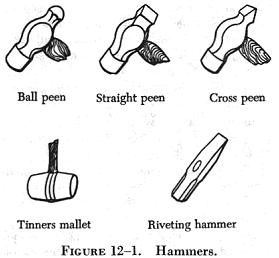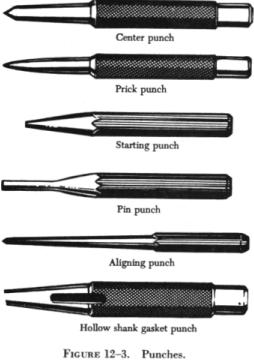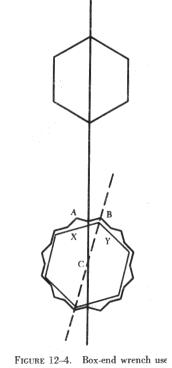GENERALPURPOSETOOLS
GENERAL PURPOSE TOOLS
Hammers and Mallets
| Figure 12-1 shows some of the hammers that the aviation
mechanic may be required to use. Metal head hammers are usually sized according
to the weight of the head without the handle.
Occasionally it is necessary to use a soft faced hammer, which has a
striking surface made of wood, brass, lead, rawhide, hard rubber, or plastic.
These hammers are intended for use in forming soft metals and striking
surfaces that are easily damaged. Soft faced hammers should not be used
for rough work. Striking punch heads, bolts, or nails will quickly ruin
this type hammer.
A mallet is a hammerlike tool with a head made of hickory, rawhide,
or rubber. It is handy for shaping thin metal parts without denting them.
Always use a wooden mallet when pounding a wood chisel or a gouge. |

|
When using a hammer or mallet, choose the one best suited for the job.
Ensure that the handle is tight. When striking a blow with the hammer,
use the forearm as an extension of the handle. Swing the hammer by bending
the elbow, not the wrist. Always strike the work squarely with the full
face of the hammer.
Always keep the faces of hammers and mallets smooth and free from dents
to prevent marring the work.
Screwdrivers
The screwdriver can be classified by its shape, type of blade, and blade
length. It is made for only one purpose, i.e., for loosening or tightening
screws or screwhead bolts. Figure 12-2 shows several
different types of screwdrivers. When using the common screwdriver, select
the largest screwdriver whose blade will make a good fit in the screw which
is to be turned.
A common screwdriver must fill at least 75 percent of the screw slot.
If the screwdriver is the wrong size, it cuts and burrs the screw slot,
making it worthless. A screwdriver with the wrong size blade may slip and
damage adjacent parts of the structures.
The common screwdriver is used only where slotted head screws or fasteners
are found on aircraft. An example of a fastener which requires the use
of a common screwdriver is the airlock fastener which is used to secure
the cowling on some aircraft.
The two types of recessed head screws in common use are the Phillips
and the Reed and Prince.
Both the Phillips and Reed and Prince recessed heads are optional on
several types of screws. As shown in Figure 12-2,
the Reed and Prince recessed head forms a perfect cross. The screwdriver
used with this screw is pointed on the end. Since the Phillips screw has
a slightly larger center in the cross, the Phillips screwdriver is blunt
on the end. The Phillips screwdriver is not interchangeable with the Reed
and Prince. The use of the wrong type screwdriver results in mutilation
of the screwdriver and the screwhead. When turning a recessed head screw,
use only the proper recessed head screwdriver of the correct size.
An offset screwdriver may be used when vertical space is limited. Offset
screwdrivers are constructed with both ends bent 90° to the shank handle.
By using alternate ends, most screws can be seated or loosened even when
the swinging space is limited. Offset screwdrivers are made for both standard
and recessed head screws.
A screwdriver should not be used for chiseling or prying. Do not use
a screwdriver to check an electric circuit since an electric arc will burn
the tip and make it useless. In some cases, an electric arc may fuse the
blade to the unit being checked.
When using a screwdriver on a small part, always hold the part in the
vise or rest it on a workbench. Do not hold the part in the hand, as the
screwdriver may slip and cause serious personal injury.
The ratchet or spiral screwdriver is fast acting in that it turns the
screw when the handle is pulled back and then pushed forward. It can be
set to turn the screw either clockwise or counterclockwise, or it can be
locked in position and used as a standard screwdriver. The ratchet screwdriver
is not a heavy duty tool and should be used only for light work. A word
of caution: When using a spiral or ratchet screwdriver, extreme care must
be used to maintain constant pressure and prevent the blade from slipping
out from the slot in the screw head. If this occurs, the surrounding structure
is subject to damage.
Pliers and Plier Type Cutting Tools
There are several types of pliers, but those used most frequently in
aircraft repair work are the diagonal, adjustable combination, needlenose,
and duckbill. The size of pliers indicates their overall length, usually
ranging from 5 to 12 inches. The 6 inch slipjoint plier, is the preferred
size for use in repair work. The slipjoint permits the jaws to be opened
wider at the hinge for gripping objects with large diameters. Slipjoint
pliers come in sizes from 5 to 10 inches. The better grades are drop forged
steel.
Flatnose pliers are very satisfactory for making flanges. The jaws are
square, fairly deep, and usually well matched, and the hinge is firm. These
are characteristics which give a sharp, neat bend.
Roundnose pliers are used to crimp metal. They are not made for heavy
work because too much pressure will spring the jaws, which are often wrapped
to prevent scarring the metal.
Needlenose pliers have half round jaws of varying lengths. They are
used to hold objects and make adjustments in tight places.
Duckbill pliers resemble a "duck's bill" in that the jaws are thin,
flat, and shaped like a duck's bill. They are used exclusively for twisting
safety wire.
Water pump (channel locks) pliers are slipjoint pliers with the jaws
set at an angle to the handles. The most popular type has the slipjoint
channeled, hence the name channel locks. These are used to grasp packing
nuts, pipe, and odd shaped parts.
Diagonal pliers are usually referred to as diagonals or "dikes." The
diagonal is a short jawed cutter with a blade set at a slight angle on
each jaw. This tool can be used to cut wire, rivets, small screws, and
cotter pins, besides being practically indispensable in removing or installing
safety wire. The duckbill pliers and the diagonal cutting pliers are used
extensively in aviation for the job of safety wiring.
Two important rules for using pliers are:
1. Do not make pliers work beyond their capacity. The longnosed variety
are especially delicate. It is easy to spring or break them, or nick the
edges. If this occurs, they are practically useless.
2. Do not use pliers to turn nuts. In just a few seconds, a pair of
pliers can damage a nut more than years of service.
| Punches
Punches are used to locate centers for drawing circles, to start holes
for drilling, to punch holes in sheet metal, to transfer location of holes
in patterns, and to remove damaged rivets, pins, or bolts.
Solid or hollow punches are the two types generally used. Solid punches
are classified according to the shape of their points. Figure 12-3 shows
several types of punches.
Prick punches are used to place reference marks on metal. This punch
is often used to transfer dimensions from a paper pattern directly on the
metal. To do this, first place the paper pattern directly on the metal.
Then go over the outline of the pattern with the prick punch, tapping it
lightly with a small hammer and making slight indentations on the metal
at the major points on the drawing. These indentations can then be used
as reference marks for cutting the metal. A prick punch should never be
struck a heavy blow with a hammer because it may bend the punch or cause
excessive damage to the material being worked. |

|
Large indentations in metal, that are necessary to start a twist drill,
are made with a center punch. It should never be struck with enough force
to dimple the material around the indentation or to cause the metal to
protrude through the other side of the sheet. A center punch has a heavier
body than a prick punch and is ground to a point with an angle of about
60°.
The drive punch, which is often called a tapered punch, is used for
driving out damaged rivets, pins, and bolts which sometimes bind in holes.
The drive punch is therefore made with a flat face instead of a point.
The size of the punch is determined by the width of the face, which is
usually 1/8 inch to 1/4 inch.
Pin punches, often called drift punches, are similar to drive punches
and are used for the same purposes. The difference in the two is that the
sides of a drive punch taper all the way to the face while the pin punch
has a straight shank. Pin punches are sized by the diameter of the face,
in thirty-seconds of an inch, and range from 1/16 to 3/8 inch in diameter.
In general practice, a pin or bolt which is to be driven out is usually
started and driven with a drive punch until the sides of the punch touch
the side of the hole. A pin punch is then used to drive the pin or bolt
the rest of the way out of the hole. Stubborn pins may be started by placing
a thin piece of scrap copper, brass, or aluminum directly against the pin
and then striking it with a hammer until the pin begins to move.
Never use a prick punch or center punch to remove objects from holes,
because the point of the punch will spread the object and cause it to bind
even more.
The transfer punch is usually about 4 inches long. It has a point that
tapers, then turns straight for a short distance in order to fit a drill
locating hole in a template. The tip has a point similar to that of a prick
punch. As its name implies, the transfer punch is used to transfer the
location of holes through the template or pattern to the material.
Wrenches
| The wrenches most often used in aircraft maintenance are
classified as open end, box end, socket, adjustable, and special wrenches.
The allen wrench, although seldom used, is required on one special type
of recessed screw. One of the most widely used metals for making wrenches
is chrome-vanadium steel. Wrenches made of this metal are almost unbreakable.
Solid, nonadjustable wrenches with open parallel jaws on one or both
ends are known as open end wrenches. These wrenches may have their jaws
parallel to the handle or at an angle up to 90°; most are set at an
angle of 15°. Basically. the wrenches are designed to fit a nut, bolthead,
or other object which makes it possible to exert a turning action.
Box end wrenches are popular tools because of their usefulness in close
quarters. They are called box wrenches since they box, or completely surround,
the nut or bolthead. Practically all box end wrenches are made with 12
points so they can be used in places having as little as 15° swing.
In figure 12-4, point A on the illustrated double broached hexagon wrench
is nearer the center line of the head and the wrench handle than point
B, and also the center line of nut C. If the wrench is inverted and installed
on nut C, point A will be centered over side "Y" instead of side "X". The
center line of the handle will now be in the dotted line position. It is
by reversing (turning the wrench over) the position of the wrench that
a 15° arc may be made with the wrench handle. |
|
Although box end wrenches are ideal to break loose tight nuts or pull
tight nuts tighter, time is lost turning the nut off the bolt once the
nut is broken loose. Only when there is sufficient clearance to rotate
the wrench in a complete circle can this tedious process be avoided.
After a tight nut is broken loose, it can be completely backed off or
unscrewed more quickly with an open end than with a box end wrench. In
this case, a combination wrench is needed, which has a box end on one end
and an open end wrench of the same size on the other. Both the box end
and combination wrenches are shown in figure 12-5.
A socket wrench is made of two parts: (1) The socket, which is placed
over the top of a nut or bolthead, and (2) a handle, which is attached
to the socket. Many types of handles, extensions, and attachments are available
to make it possible to use socket wrenches in almost any location or position.
Sockets are made with either fixed or detachable handles. Socket wrenches
with fixed handles are usually furnished as an accessory to a machine.
They have either a four, six or twelve sided recess to fit a nut or bolthead
that needs regular adjustment.
Sockets with detachable handles usually come in sets and fit several
types of handles, such as the T, ratchet, screwdriver grip, and speed handle.
Socket wrench handles have a square lug on one end that fits into a square
recess in the socket head. The two parts are held together by a light spring
loaded poppet. Two types of sockets, a set of handles, and an extension
bar are shown in figure 12-6.

The adjustable wrench is a handy utility tool which has smooth jaws
and is designed as an open end wrench. One jaw is fixed, but the other
may be moved by a thumbscrew or spiral screwworm adjustment in the handle.
The width of the jaws may be varied from 0 to 1/2 inch or more. The angle
of the opening to the handle is 22 1/2° on an adjustable wrench. One
adjustable wrench does the work of several open end wrenches. Although
versatile, they are not intended to replace the standard open end, box
end, or socket wrenches. When using any adjustable wrench, always exert
the pull on the side of the handle attached to the fixed jaw of the wrench.
Special Wrenches
The category of special wrenches includes the spanner, torque, and allen
wrenches. The hook spanner is for a round nut with a series of notches
cut in the outer edge. This wrench has a curved arm with a hook on the
end which fits into one of the notches on the nut. The hook is placed in
one of these notches with the handle pointing in the direction the nut
is to be turned.
Some hook spanner wrenches are adjustable and will fit nuts of various
diameters. U-shaped hook spanners have two lugs on the face of the wrench
to fit notches cut in the face of the nut or screw plug. End spanners resemble
a socket wrench but have a series of lugs that fit into corresponding notches
in a nut or plug. Pin spanners have a pin in place of a lug, and the pin
fits into a round hole in the edge of a nut. Face pin spanners are similar
to the U-shaped hook spanners except that they have pins instead of lugs.
There are times when definite pressure must be applied to a nut or bolt.
In such cases a torque wrench must be used. The torque wrench is a precision
tool consisting of a torque indicating handle and appropriate adapter or
attachments. It measures the amount of turning or twisting force applied
to a nut, bolt, or screw.
The three most commonly used torque wrenches are the deflecting beam,
dial indicating, and micrometer setting types. When using the deflecting
beam and the dial indicating torque wrenches, the torque is read visually
on a dial or scale mounted on the handle of the wrench. The micrometer
setting torque wrench is preset to the desired torque. When this torque
is reached, a sharp impulse or breakaway is noticed by the operator.
Before each use, the torque wrench should be visually inspected for
damage. If a bent pointer, cracked or broken glass (dial type), or signs
of rough handling are found, the wrench must be tested. Torque wrenches
must be tested at periodic intervals to ensure accuracy.
Most headless setscrews are the allen type and must be installed and
removed with an allen wrench. Allen wrenches are six sided bars in the
shape of an L. They range in size from 3/64 to 1/2 inch and fit into a
hexagonal recess in the setscrew.



